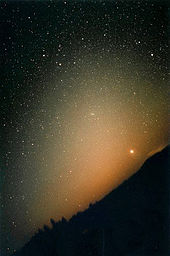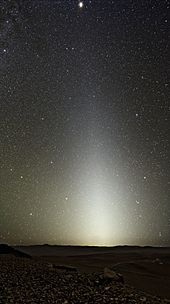Zodiacal light

Zodiacal light is a faint, roughly triangular, diffuse white glow seen in the night sky that appears to extend up from the vicinity of the Sun along the ecliptic or zodiac.[1] It is best seen just after sunset and before sunrise in spring and autumn when the zodiac is at a steep angle to the horizon. Caused by sunlight scattered by space dust in the zodiacal cloud, it is so faint that either moonlight or light pollution renders it invisible.
The zodiacal light decreases in intensity with distance from the Sun, but on very dark nights it has been observed in a band completely around the ecliptic. In fact, the zodiacal light covers the entire sky, being responsible for major part[2](60%[citation needed]) of the total skylight on a moonless night. There is also a very faint, but still slightly increased, oval glow directly opposite the Sun which is known as the gegenschein.
The dust forms a thick pancake-shaped cloud in the Solar System collectively known as the zodiacal cloud, which occupies the same plane as the ecliptic. The dust particles are between 10 and 300 micrometres in diameter, with most mass around 150 micrometres.[3]
Viewing

In the mid-latitudes, the zodiacal light is best observed in the western sky in the spring after the evening twilight has completely disappeared, or in the eastern sky in the autumn just before the morning twilight appears. The zodiacal light appears as a column, brighter at the horizon, tilted at the angle of the ecliptic. Since the light scattered from extremely small dust particles is strongly forward scattering, although the zodiacal light actually extends all the way around the sky, it is brightest when observing at a small angle with the sun. This is why it is most clearly visible near sunrise or sunset, when the sun is blocked, but the dust particles nearest the line of sight to the sun are not. The dust band that causes the zodiacal light is uniform across the whole ecliptic.
The dust further from the ecliptic is almost undetectable except when viewed at a small angle with the sun. Thus it is possible to see more of the width at small angles toward the sun, and it appears wider near the horizon, closer to the sun under the horizon.
Origin
The source of that dust was long debated. Until recently, it was thought that the dust originated from the tails of active comets and from collisions between asteroids in the asteroid belt.[4] Peter Jenniskens had previously recognized that many of our meteor showers have no known active comet parent bodies. In a 2010 article in the Astrophysical Journal, David Nesvorny and Peter Jenniskens attributed over 85 percent of the dust to occasional fragmentations of Jupiter Family Comets that are nearly dormant.[5] Jupiter Family Comets have orbital periods of less than 20 years[6] and are considered dormant when not actively outgassing, but may do so in the future.[7] Nesvorny and Jenniskens' first fully dynamical model of the zodiacal cloud demonstrated that only if the dust was released in orbits that approach Jupiter, is it stirred up enough to explain the thickness of the zodiacal dust cloud. The dust in meteoroid streams is much larger, 300 to 10,000 micrometres in diameter, and falls apart in smaller zodiacal dust grains over time.
The Poynting-Robertson effect forces the dust into more circular (but still elongated) orbits, while spiralling slowly into the Sun. Hence a continuous source of new particles is needed to maintain the zodiacal cloud. Cometary dust and dust generated by collisions among the asteroids are believed to be mostly responsible for the maintenance of the dust cloud producing the zodiacal light and the gegenschein.
Particles can be reduced in size by collisions or by space weathering. When ground down to sizes less than 10 micrometres, the grains are removed from the inner solar system by solar radiation pressure. The dust is then replenished by the infall from comets. Zodiacal dust around nearby stars is called exozodiacal dust; it is a potentially important source of noise for directly imaging extrasolar planets. Nesvorny and Jenniskens have pointed out that this exozodiacal dust, or hot debris disks, can also help find planets, as planets tend to scatter the comets to the inner solar system.
Appearance

Zodiacal light is produced by sunlight reflecting off dust particles in the solar system known as cosmic dust. Consequently, its spectrum is the same as the solar spectrum. The material producing the zodiacal light is located in a lens-shaped volume of space centered on the sun and extending well out beyond the orbit of Earth. This material is known as the interplanetary dust cloud. Since most of the material is located near the plane of the solar system, the zodiacal light is seen along the ecliptic. The amount of material needed to produce the observed zodiacal light is quite small. If it were in the form of 1 mm particles, each with the same albedo (reflecting power) as Earth's moon, each particle would be 8 km from its neighbors. The gegenschein may be because particles directly opposite the sun as seen from Earth would be in full phase.
According to Nesvorny and Jenniskens, when the dust grains are as small as about 150 micrometres in size, they will hit the Earth at an average speed of 14.5 km/s, many as slowly as 12 km/s. If so, they pointed out, this comet dust can survive entry in partially molten form, accounting for the unusual attributes of the micrometeorites collected in Antarctica, which do not resemble the larger meteorites known to originate from asteroids. In recent years, observations by a variety of spacecraft have shown significant structure in the zodiacal light including dust bands associated with debris from particular asteroid families and several cometary trails.
History
Previously, it was believed that zodiacal light was just the atmosphere of the sun. According to the 1728 Cyclopaedia:
- "The zodiacal light is nothing but the solar atmosphere, a rare and subtile fluid, either luminous by itself, or made so by the rays of the sun surrounding its globe; but in a greater quantity, and more extensively, about its equator, than any other."
The phenomenon of zodiacal light was first investigated by the astronomer Giovanni Domenico Cassini in 1683 and first explained by Nicolas Fatio de Duillier in 1684. The glow was first correctly identified as being due to scattered sunlight from dust particles in the solar system by Joshua Childrey in 1661.
Importance to Islam
The Islamic prophet Muhammed described zodiacal light in reference to the timing of the five daily prayers, calling it the "false dawn," (Arabic: al-fajr al-kaadhib الفجر الكاذب). Muslim oral tradition preserves numerous sayings, or hadith, in which Muhammed describes the difference between the light of false dawn, appearing in the sky long after sunset, and the light of the first band of horizontal light at sunrise, the true dawn. Practitioners of Islam use Muhammed's descriptions of zodiacal light to avoid errors in determining the timing of daily prayers. Such practical descriptions and applications of astronomical observations were vital to the golden age of Islamic astronomy.
Use of the term "false dawn" in this context should not be confused with false sunrise, which is a different, unrelated optical phenomenon.
Brian May
In August 2007, Brian May, lead guitarist with the band Queen, handed in his PhD thesis Radial Velocities in the Zodiacal Dust Cloud 36 years after starting it and then abandoning it in favour of a musical career. That he was able to submit it was possible only because of the minimal amount of research on the topic that had been carried out in the intervening years. May describes the subject as being one that became "trendy" again in the 2000s.[8]
See also
- Exozodiacal dust
- Gegenschein
- Interplanetary dust cloud
- Islamic astronomy
- Optical phenomenon
- Zodiacal dust
References
- ^ Internet Encyclopedia of Science Accessed April 2010
- ^ Reach, W. T. (1997). "The structured zodiacal light: IRAS, COBE, and ISO observations", page 1 (in Introduction)
- ^ Peucker-Ehrenbrink, Bernhard; Schmitz, Birger (2001). Accretion of extraterrestrial matter throughout earth's history. Springer. pp. 66–67. ISBN 0-306-46689-9.
{{cite book}}: CS1 maint: multiple names: authors list (link) - ^ "Towards a Global Model of the Zodiacal Cloud". DPS meeting abstract, Espy, Ashley J.; Dermott, S.; Kehoe, T. J., 2006.
- ^ "Cometary Origin of the Zodiacal Cloud and Carbonaceous Micrometeorites. Implications for hot debris disks". Astrophysical Journal Vol. 713 (April 20, 2010). Retrieved 2010-04-20.
- ^ Jenniskens, Petrus Matheus Marie (2006). Meteor showers and their parent comets. Cambridge University Press. p. 108. ISBN 978-0-521-85349-1.
- ^ SPACE.com Staff (6 January 2011). "Comet or Asteroid? Big Space Rock Has Identity Crisis". SPACE.com. Retrieved 23 May 2011.
Dormant comets retain some subsurface volatiles and may start outgassing once again as they near the sun.
- ^ Terri Gross interviews Brian May, "National Public Radio show Fresh Air"
External links
- Reach, W. T. (1997). "The structured zodiacal light: IRAS, COBE, and ISO observations". Diffuse Infrared Radiation and the IRTS. ASP Conference Series. 124, 33–40
- A Brief History of Observations
- "Zodiacal Light and the Gegenschein", an essay by J. E. Littleton
- Zodiacal Light and the False Dawn September 25, 2007
- Zodiacal Light Over Laguna Verde October 29, 2009
- Zodiacal light as seen from above the Himalayan Hills in Uttarakhand, India
- Examples of zodiacal light descriptions in Islamic tradition, and their application

